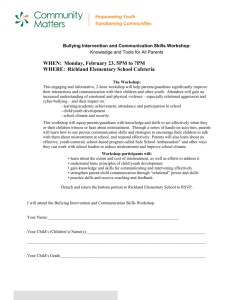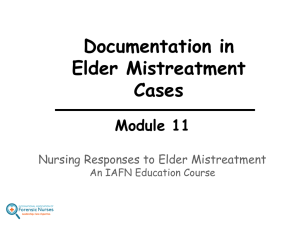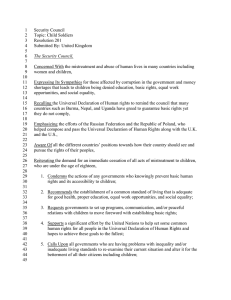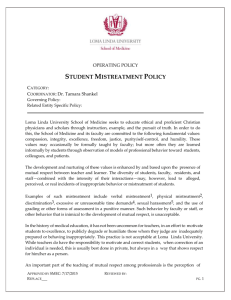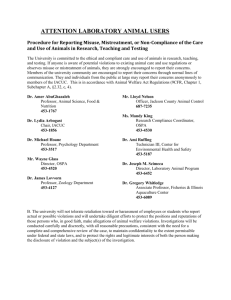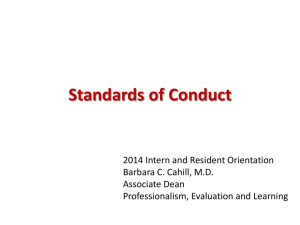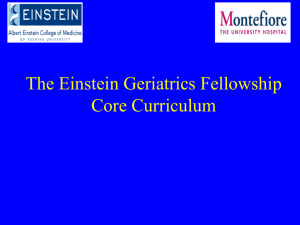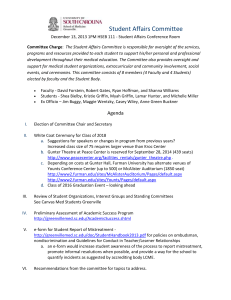The Experiences, Perceptions, and Help-Seeking Behaviors of Elder Mistreatment among
advertisement
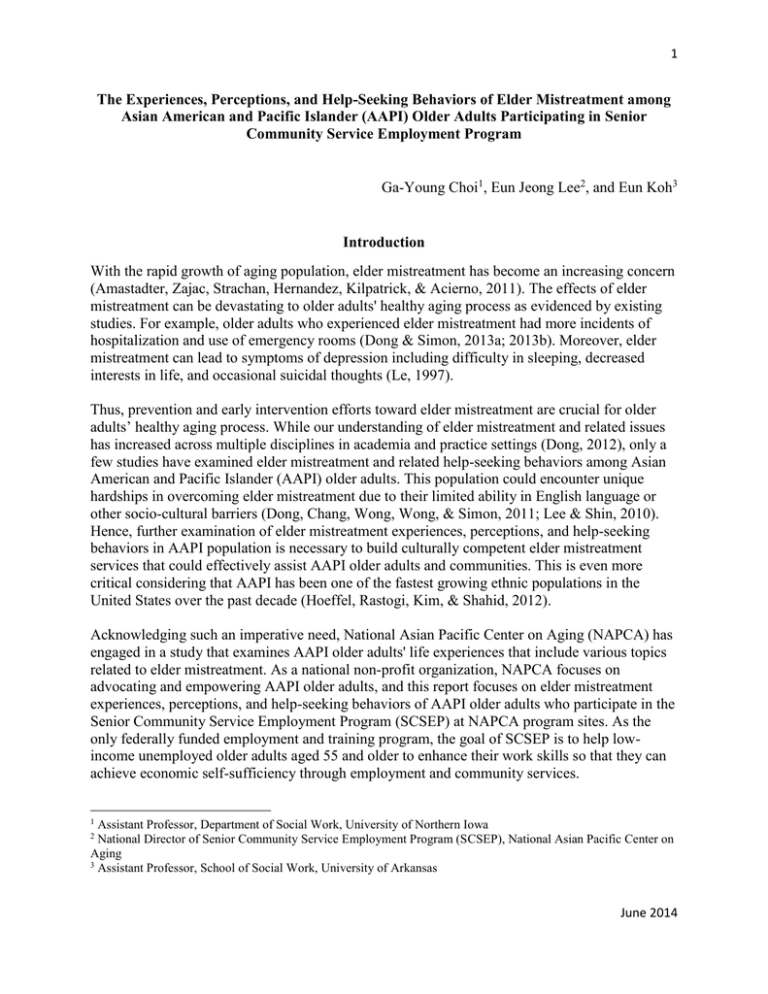
1 The Experiences, Perceptions, and Help-Seeking Behaviors of Elder Mistreatment among Asian American and Pacific Islander (AAPI) Older Adults Participating in Senior Community Service Employment Program Ga-Young Choi1, Eun Jeong Lee2, and Eun Koh3 Introduction With the rapid growth of aging population, elder mistreatment has become an increasing concern (Amastadter, Zajac, Strachan, Hernandez, Kilpatrick, & Acierno, 2011). The effects of elder mistreatment can be devastating to older adults' healthy aging process as evidenced by existing studies. For example, older adults who experienced elder mistreatment had more incidents of hospitalization and use of emergency rooms (Dong & Simon, 2013a; 2013b). Moreover, elder mistreatment can lead to symptoms of depression including difficulty in sleeping, decreased interests in life, and occasional suicidal thoughts (Le, 1997). Thus, prevention and early intervention efforts toward elder mistreatment are crucial for older adults’ healthy aging process. While our understanding of elder mistreatment and related issues has increased across multiple disciplines in academia and practice settings (Dong, 2012), only a few studies have examined elder mistreatment and related help-seeking behaviors among Asian American and Pacific Islander (AAPI) older adults. This population could encounter unique hardships in overcoming elder mistreatment due to their limited ability in English language or other socio-cultural barriers (Dong, Chang, Wong, Wong, & Simon, 2011; Lee & Shin, 2010). Hence, further examination of elder mistreatment experiences, perceptions, and help-seeking behaviors in AAPI population is necessary to build culturally competent elder mistreatment services that could effectively assist AAPI older adults and communities. This is even more critical considering that AAPI has been one of the fastest growing ethnic populations in the United States over the past decade (Hoeffel, Rastogi, Kim, & Shahid, 2012). Acknowledging such an imperative need, National Asian Pacific Center on Aging (NAPCA) has engaged in a study that examines AAPI older adults' life experiences that include various topics related to elder mistreatment. As a national non-profit organization, NAPCA focuses on advocating and empowering AAPI older adults, and this report focuses on elder mistreatment experiences, perceptions, and help-seeking behaviors of AAPI older adults who participate in the Senior Community Service Employment Program (SCSEP) at NAPCA program sites. As the only federally funded employment and training program, the goal of SCSEP is to help lowincome unemployed older adults aged 55 and older to enhance their work skills so that they can achieve economic self-sufficiency through employment and community services. 1 Assistant Professor, Department of Social Work, University of Northern Iowa National Director of Senior Community Service Employment Program (SCSEP), National Asian Pacific Center on Aging 3 Assistant Professor, School of Social Work, University of Arkansas 2 June 2014 2 Research Procedure This report describes findings from 60 anonymous survey responses collected from SCSEP participants at NAPCA's Los Angeles and Orange County project sites, California. The survey was conducted between March 2013 and June 2013. Older adults who identified their ethnicity as AAPI, were living in the United States, and were 55 years old or older were eligible to participate in the study. The age requirement of the study was consistent with that of SCSEP. Face-to-face structured interviews were conducted with 60 participants either in English or in Korean as only English-Korean bilingual interviewers were available at the time of the interviews. The research participants' identifiable information such as name, phone number, and address was not collected to ensure the anonymity and privacy of the participants. In the subsequent sections of this report, we discuss the study participants' demographic and other background information, and more importantly, their life experiences including their ability to maintain daily activities as well as elder mistreatment experiences, perceptions, and helpseeking behaviors. The survey questionnaires were developed based on the National Elder Mistreatment Study questionnaires (Acierno, Hernandez-Tejada, Muzzy, & Steve, 2009) to examine participants’ elder mistreatment experiences. In addition, various existing literature that discusses elder mistreatment in minority ethnic communities was utilized in developing the questionnaires to explore perceptions and help-seeking behaviors of AAPI older adults. Participant Characteristics While AAPI older adults 55 years old or older were eligible to participate in the study, the majority of the participants were 60 years old or older (83.3%, n=50) with the mean age of 64.7 years old (SD=5.73, range: 55-84). Figure 1 presents detailed information on the participants’ age. Figure 1. Age of the Study Participants (N=60) 50s 60s 70s 80s 80s 1.7% 70s 21.7% 50s 16.7% 60s 60% The majority of the study participants were females (61.7%, n=37) and living with family members or a roommate (81.7%, n=49). A little over half of the participants were living with spouses (51.7%) and approximately one fifth of the participants were living with their adult June 2014 3 children (21.7%). Only 18.3% of the participants reported living alone. In terms of AAPI ethnicity composition of the study participants, the majority was Korean (63.3%), followed by Filipino (25.0%), Chinese and Taiwanese (6.7%), and Cambodian and Pakistani (5.0%). A large percentage of participants held a 4-year college or master's degree (65.0%, n=39). On average, the study participants had lived in the U.S. for 21.1 years (SD=13.04) ranging from two to 43 years. Most AAPI older adults in the current study were foreign born first generation immigrants (80.0%). Approximately 42%-53% of the study participants reported feeling comfortable in using English language in speaking, reading, and writing. In other words, 47%58% of the participants felt uncomfortable in using English language in their daily lives to some extent. Experiences of Elder Mistreatment Activities of daily living The participants were asked who mainly managed their daily activities to explore whether they have difficulties in performing basic living necessities and to detect any potential risk of being neglected. Overall, the AAPI older adults in SCSEP maintained independent living, which implies that they have a low risk of being neglected. Overall, the AAPI older adults in the SCSEP maintained independent living, which implies that they have a low risk of being neglected. The SCSEP participants in Los Angeles and Orange County sites reported driving own car (61.7%, n=37) and using public transportation (40.0%, n=24) as the two major methods of transportation (Figure 2). Geographical traits of the respondents, such as the availability of public transportation in a metropolitan or suburban area, might have affected the participants’ responses on their major methods of transportation. Figure 2. Method of Transportation (N=60) 70 61.7% 60 50 40.0% 40 30 20 6.7% 10 5.0% 0 Self driving Public transportation Ride Walk June 2014 4 As shown in Figure 3, a high percentage of respondents themselves were checking whether they had enough food, medicines or other necessities in their homes (78.3%, n=47). Household chores such as cooking, cleaning, or yard work were also mostly handled by the respondents themselves without any problem (63.3%, n=38). Approximately one fifth of the sample (22.0%) reported that their spouses mainly handled the household chores or considered it as co-responsibility between their spouses and themselves. Only three respondents reported needing help with household chores and all of them already had someone assisting them. The vast majority of the respondents themselves were making sure that their bills were paid (83.3%, n=50) with 16% of them sharing the responsibility with their family members. For those who didn't take care of the bills on their own, family members such as spouses or adult children usually took care of it (15.0%). Figure 3 describes the percentage of older adults who self-managed different tasks of daily living. Figure 3. Percentage of Older Adults Self-Managing Core Daily Activities (N=60) 100 80 83.3% 78.3% 63.3% 60 40 20 0 Check living necessities House chores Bill pay Experiences of elder mistreatment: Financial, emotional, physical, and sexual mistreatment Out of the 60 AAPI older adults, 40% reported having experienced at least one type elder mistreatment with emotional mistreatment being the most frequently reported type of mistreatment (26.7%) followed by financial (18.3%), physical (1.7%), and sexual (1.7%) mistreatment (Figure 4). Forty percent of the current study participants have experienced at least one type elder mistreatment with emotional mistreatment being the most frequently reported type of mistreatment. June 2014 5 Figure 4. Types of Elder Mistreatment Experienced (N=60) 50% 40.0% 40% 30% 26.7% 18.3% 20% 10% 1.7% 1.7% Physical mistreatment Sexual mistreatment 0% At least one type of mistreatment Financial mistreatment Emotional mistreatment Financial treatment Almost 1 out of 5 SCSEP participants in the study experienced financial mistreatment in their lifetime. Close to one third of the older adults (28.3%, n=17) had someone who helped them with taking care of their financial assets such as decision-making in financial management. All of them identified family members (e.g. spouses or adult children) as persons who helped with their financial management and one person also reported receiving help from a friend. Most of them (70.5%) believed that their helpers made good decisions about their financial issues whereas two persons (11.8%) didn’t believe so (see Figure 5). Three older adults didn’t provide their opinions about whether their helpers were helpful in managing their financial assets (17.6%). Figure 5. Beliefs about the helper's financial decision-making (N=17) Helper doesn't make good decisions 11.8% No response 17.6% Helper makes good decisions 70.5% June 2014 6 Approximately 18% of the AAPI older adults in the study have experienced financial mistreatment in their lifetime from acquaintances or strangers in the form of being forced or tricked to sign financial documents, having their money or possessions stolen, and their signatures being forged. However, it cannot be determined from the study whether they actually encountered financial mistreatment due to their older adult status or not because the questions in the survey inquired about their lifetime experiences in the aforementioned financial mistreatment activities, which any individual can experience regardless of their age. Two of the respondents reported that their financial mistreatment experiences were mail and credit card fraud. Emotional mistreatment Emotional mistreatment was the most frequently reported type of mistreatment in the current study. Approximately 27% of them reported experiencing at least one form of emotional mistreatment within the prior 12 months, including verbal mistreatment (11.7%), feeling humiliated (20.0%), harassed or coerced (6.7%), or ignored (11.7%). Colleagues including coworkers and supervisors were the most frequently identified persons as someone who emotionally mistreated the AAPI older adults (n=9). The relatively higher rate of emotional mistreatment by colleagues, compared to others, might be due to the fact that the survey respondents were all SCSEP participants, who work daily at employment training sites. A small number of respondents also reported their spouses (n=3), a stranger (n=1), a friend (n=1), and a relative and roommate (n=1) as persons who emotionally mistreated them. Physical & sexual mistreatment Physical and sexual mistreatments were the least reported elder mistreatment types in the study. Physical mistreatment was reported by one respondent; according to this respondent, it occurred occasionally and this person was injured from the physical mistreatment. One of the study participants reported experiencing an incident of sexual mistreatment committed by an acquaintance, and this was reported to the authority. Perceptions of Elder Mistreatment To explore what behaviors AAPI older adults perceived as elder mistreatment, the study participants were asked to rate to what extent they thought given hypothetical statements were elder mistreatment. A fewer older adults viewed their adult children not paying back after borrowing money from them as elder mistreatment (38.3%). June 2014 7 Figure 6. Perceptions of Elder Mistreatment (N=60) 100 78.3% 80 80.0% 70.0% 60 44.1% 20 0 40.0% 36.6% 40 27.1% 28.4% 30.0% 31.7% 38.3% 11.7% 1.7% Disrespect 1.7% 8.3% Ignoring needs Disagree 20.0% 16.6% 1.7% 10.0% Frequent comments to send nursing home Neutral 3.3% Yelling Agree 1.7% Not paying borrowed money 8.3% 6.0% 1.7% Accessing financial accounts without permissions No response As presented in Figure 6, the majority of the AAPI older adults considered their spouses or adult children accessing their financial accounts without their permissions as financial mistreatment (80.0%, n=48). A fewer older adults viewed their adult children not paying back after borrowing money from them as elder mistreatment (38.3%, n=23), but a slightly more number of the older adults didn't perceive it as elder mistreatment (40%, n=24). Moreover, the majority of the study participants perceived family members telling them that the family will send them to nursing homes against their will as elder mistreatment (78.0%, n=47). A great number of the older adults also perceived their adult children yelling at them as elder mistreatment (70%, n=42). On the other hand, only a small number of the AAPI older adults considered the following as elder mistreatment: their spouses or adult children disrespecting their opinions (26.7%. n=16) and ignoring their needs (36.6%, n=22). Elder Mistreatment Help-Seeking Behaviors The majority of AAPI older adults reported that they did not hear about Adult Protective Services (APS) before participating in the study (73.3%). Following an interviewer's brief explanation about APS, the study participants were asked to rate how likely they would seek help from APS if they were experiencing specific types of elder mistreatment. The majority of the study participants perceived family members telling them that the family will send them to nursing homes against their will as elder mistreatment. June 2014 8 Figure 7. Intention to seek help from APS: By different types of elder mistreatment (N=60) 100% 80% 76.7% 65.0% 63.3% 60% 58.4% 48.4% 40% 20% 0% Sexual Mistreatment Physical Mistreatment Neglect Financial Mistreatment Emotional Mistreatment A significantly high percentage of AAPI older adults in the study reported that they were likely to seek help from APS if they were experiencing elder mistreatment in general (90.0%). Specifically, 65.0% and 63.3% of the older adults reported that they were likely to contact APS if they ever encountered physical mistreatment and neglect, respectively. In addition, over half of the study participants reported that they would consider contacting APS if they were experiencing financially mistreatment (58.4%). A lower percentage of participants reported that they would be likely to contact APS in case of emotional mistreatment (48.4%, n=29). The study participants were more willing to seek help from APS if they encountered sexual mistreatment than any other type of mistreatment (76.7%, n=46) (Figure 7). Thirty-eight percent (n=23) of the respondents reported that they would be either ‘very unlikely’ or ‘unlikely’ to seek help from APS for any type of mistreatment. Reasons for not seeking APS services include having English language barriers, feeling uncomfortable in reporting private problems to the third party, considering elder mistreatment as a family matter, and preferring private sources of help such as family, friends, and religion. Two respondents also reported that they would contact APS in case of crisis. While a large number of the AAPI older adults considered seeking help from APS (90.0%), the majority of the older adults chose family as their top choice for obtaining help in case of elder mistreatment (71.7%). June 2014 9 While a large number of AAPI older adults considered seeking help from APS, the majority of them chose family members as their top preferred resource for help if they encountered elder mistreatment (71.7%, n=43). The second ranked preference was APS selected by 13.3% of the sample. Other preferred source of support include friends (6.7%), religious communities (5.0%), and police (3.3%) (Figure 8). Figure 8. Preferred Source of Help (N=60) 100 80 71.7% 60 40 20 13.3% 6.7% 5.0% 3.3% Friends Religious community Police 0 Family members or relatives APS When the AAPI older adults were asked whether they knew an organization or a professional to turn to if they were being abused or mistreated, many of them replied 'no' (63.3%, n=38) and only one third of them said 'yes' (33.3%, n=20). The study participants who reported knowing professional resources identified the following as potential sources of help for elder mistreatment: ethnic specific service agencies (n=8), police or 911 (n=6), churches or pastors (n=2), and APS (n=1). One person couldn't remember a specific name of the agency but reported that she knew an agency where she could ask for help. June 2014 10 Implications While the findings are preliminary, the results have significant implications for elder mistreatment services for AAPI older adults. The prevalence of more visible types of elder mistreatment such as physical or sexual mistreatment was very low among the SCSEP participants in this study. However, 40% of the study participants experienced at least one type of elder mistreatment, and over 50% of them were related to emotional mistreatment. Therefore, to prevent negative psychological symptoms rising from emotional mistreatment, initial detection and intervention efforts should be made by the helping professionals who serve AAPI older adults and also by the older adults themselves. Colleagues from work were the most frequently reported persons who have emotionally mistreated AAPI older adults in the study. These experiences among the SCSEP participants might be due to cultural differences between participants’ home countries and the U.S. For example, showing respect to older people in verbal and behavioral communications is a social virtue in Asian culture, which is less valued and visible in the U.S. Therefore, it is important to educate staff at SCSEP training sites about not only elder mistreatment, but also cultural competency in their work with older AAPI adults. Moreover, the agencies should have organizational policies or protocols that protect older adults from elder mistreatment within their work environment. The older adults in the study perceived certain behaviors of their family members or caretakers, such as not paying borrowed money back to the older adults and frequently telling them about sending them to nursing homes, as elder mistreatment. Such perceptions may have been influenced by AAPI cultural values of collectivism. Thus, culturally competent elder mistreatment services must take place. Furthermore, the study findings suggest that if AAPI older adults are aware of elder mistreatment preventive and intervention efforts of APS, they are likely to seek help from APS. Therefore, it is crucial that social service providers and the state APS actively reach out to AAPI communities, especially in disseminating APS program information. In this study, a half of the older adults who reported knowing specific organizations or professionals where they could ask for help in case of elder mistreatment named their ethnic specific service agencies, and churches or pastors. This finding implies that close collaborations among AAPI service providers, community leaders, and APS are important. June 2014 11 References Acierno, R., Hernandez-Tejada, M., Muzzy, W., & Steve, K. (2009). Final report: The National Elder Mistreatment Study. The National Institute of Justice. Retrieved from https://www.ncjrs.gov/pdffiles1/nij/grants/226456.pdf Amstadter, A. B., Zajac, K., Strachan, M., Hernanez, M.A., Kilpatrick, D. G., Acierno, R. (2011). Prevalence and correlates of elder mistreatment in South Carolina: The South Carolina elder mistreatment study. Journal of Interpersonal Violence, 26, 2947-2972. Dong, X., Chang, E.-S., wong, E., Wong, B., & Simon, M.A. (2011). How do U.S. Chinese older adults view elder mistreatment? Findings from a community-based participatory research study. Journal of Aging and Health, 23, 289-312. Dong, X., & Simon, M. A. (2013a). Association between elder abuse and use of ED: Findings from the Chicago Health and Aging Project. Am J Emerg Med, 31(4), 693-698. doi: 10.1016/j.ajem.2012.12.028 Dong, X., & Simon, M. A. (2013b). Elder abuse as a risk factor for hospitalization in older persons. JAMA Intern Med, 1-7. doi: 10.1001/jamainternmed.2013.238 Hoeffel, E. M., Kim, M. O., & Shahhid, H. (March, 2012). The Asian population: 2010. 2010 Census Briefs. U.S. Department of Commerce: Economics and Statistics Administration. U.S. Census Bureau. Le, Q. K. (1997). Mistreatment of Vietnamese elderly by their families in the United States. Journal of Elder Abuse & Neglect, 9, 51-62. Lee, H. Y., & Shin, N. (2010). Cultural view on the response to mistreatment of elderly Korean American immigrants: A social development intervention. Social Development Issues, 32, 89-110. Acknowledgement: This study was funded in part by the University Northern Iowa (UNI) 201213 Capacity Building Grant; UNI 2013 College of Behavioral and Social Sciences Project Grant; and UNI 2013 Summer Fellowship. The authors would like to thank Ms. Christine Takada, Ms. Miriam Suen, and Mr. Norman Lee at NAPCA for their collaboration in the data collection process. The authors also would like to thank Yali Feng, Maria Lee, and Alyssa Plunkett for their assistance in this research project, and Dr. Ronald Acierno for granting permission to use National Elder Mistreatment Questionnaires. June 2014
